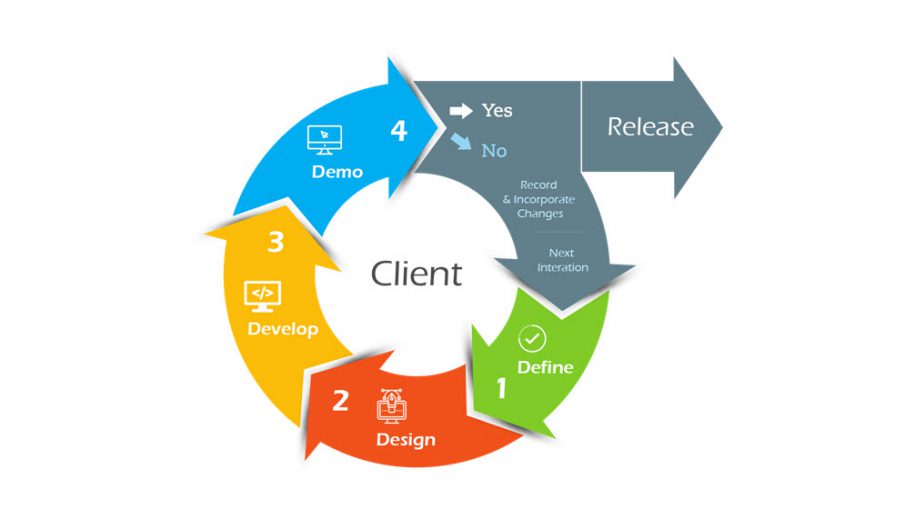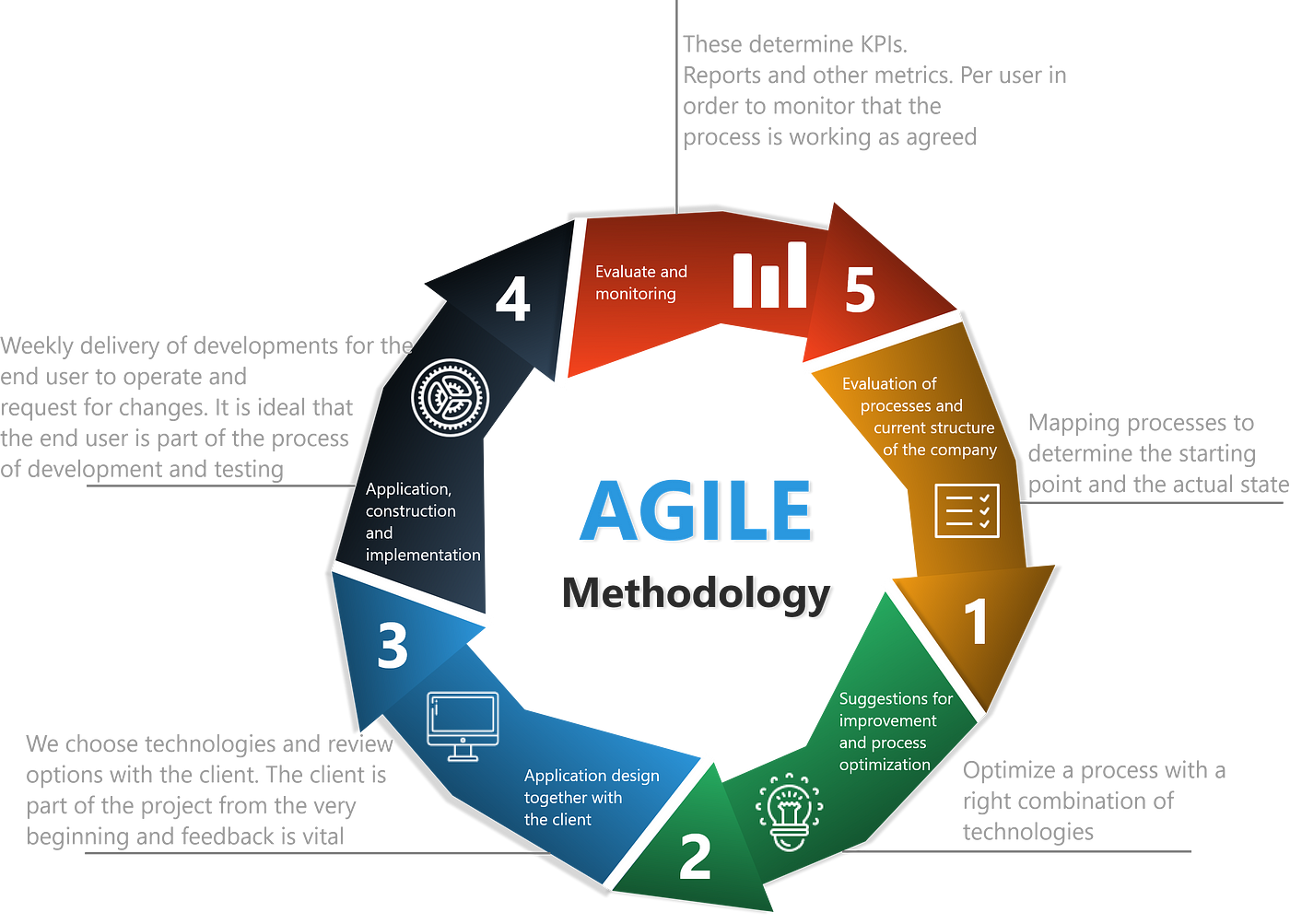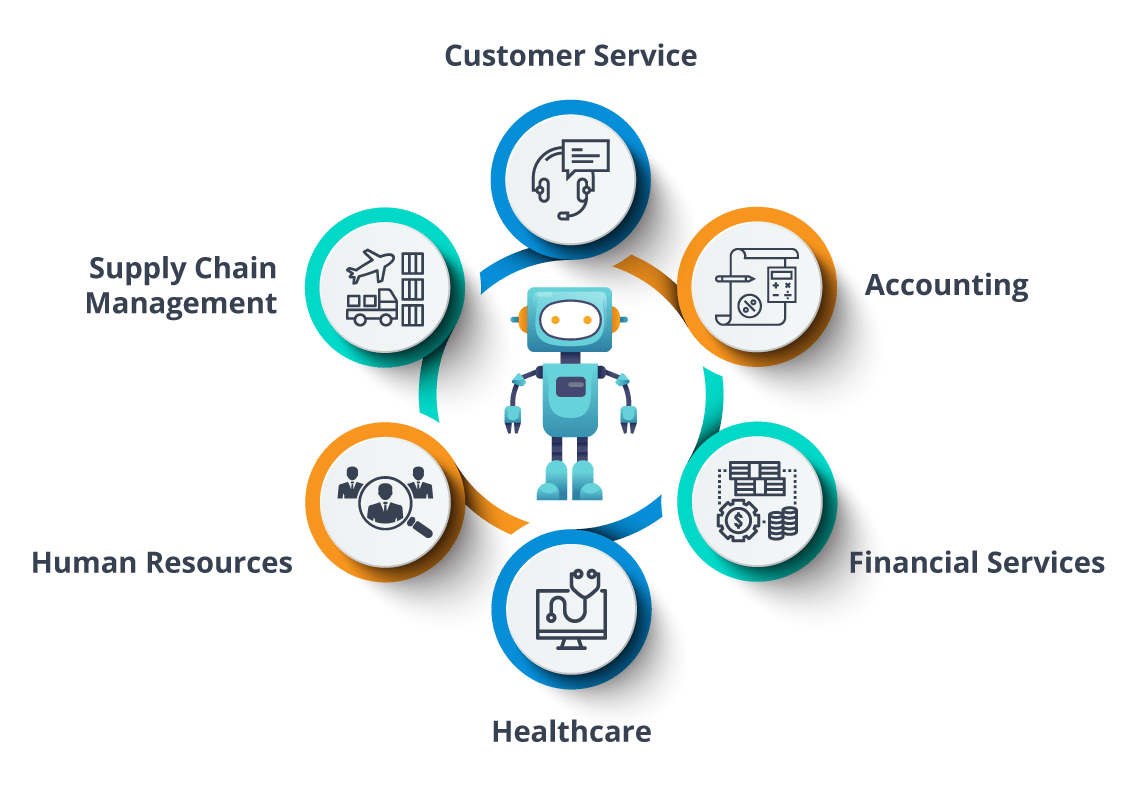
by JBM Digital | Sep 16, 2024 | Customer experience in business optimization and automation, Integration

Image Source: FreeImages
Introduction to Agile Methodologies
In today’s rapidly evolving business landscape, organizations constantly seek ways to enhance their operational efficiency, adaptability, and responsiveness to market demands. One approach that has gained significant traction in recent years is the adoption of Agile methodologies. Agile is a flexible, iterative, and collaborative approach to project management and software development that has the potential to transform the way your business operates.
This article will guide you through the principles and benefits of Agile, explore the various Agile frameworks, and provide practical insights on how to implement Agile across different departments of your organization. By the end of this article, you will have a comprehensive understanding of how embracing Agile can unlock your business’s full potential and drive optimal process optimization.
Understanding the Principles of Agile
At the heart of Agile lies a set of core principles that emphasize flexibility, collaboration, and continuous improvement.

These principles include:
- Adaptive Planning: Agile embraces the concept of adaptive planning, where teams regularly review and adjust their plans based on changing requirements, feedback, and market conditions.
- Iterative Development: Agile projects are divided into smaller, manageable iterations or “sprints,” allowing for quicker delivery of value and the ability to incorporate feedback and make adjustments along the way.
- Continuous Delivery: Agile encourages the frequent and incremental delivery of working products or services, ensuring that your customers receive value regularly.
- Cross-Functional Collaboration: Agile teams are typically composed of individuals with diverse skills and expertise, fostering a collaborative environment where everyone contributes to the overall success of the project.
- Customer Centricity: Agile places a strong emphasis on understanding and addressing the needs of your customers, ensuring that your products or services align with their expectations.
By embracing these principles, your organization can unlock new levels of efficiency, responsiveness, and innovation, ultimately driving sustainable growth and success.
Benefits of Adopting Agile Methodologies in Business
Embracing Agile methodologies can provide your business with a multitude of benefits, including:
- Improved Adaptability: Agile’s iterative approach allows you to quickly respond to changing market conditions, customer feedback, and evolving business requirements, enabling your organization to stay ahead of the curve.

- Enhanced Productivity: Agile’s focus on continuous improvement, collaboration, and the elimination of waste can lead to significant improvements in team productivity and overall project efficiency.
- Increased Customer Satisfaction: By prioritizing customer needs and delivering value in frequent, incremental releases, Agile helps you better align your offerings with customer expectations, leading to higher levels of satisfaction and loyalty.
- Reduced Risk: Agile’s emphasis on continuous feedback and incremental delivery helps mitigate the risks associated with large-scale, monolithic projects, allowing you to identify and address issues early on.
- Fostered Innovation: Agile’s collaborative nature and openness to experimentation create an environment that encourages innovation, enabling your teams to explore new ideas and solutions.
By embracing Agile methodologies, you can unlock your business’s full potential and drive optimal process optimization, positioning your organization for long-term success in an increasingly competitive and dynamic market.
Agile Frameworks – Scrum, Kanban, and Lean
While Agile is a broad philosophy, several Agile frameworks provide more specific guidance and structure for implementing Agile practices. Three of the most widely adopted Agile frameworks are:
- Scrum: Scrum is a popular Agile framework that emphasizes the use of short, iterative “sprints” to deliver working products or services. The Scrum team consists of a Product Owner, a Scrum Master, and cross-functional team members. Key Scrum events include Sprint Planning, Daily Standups, Sprint Reviews, and Sprint Retrospectives.

- Kanban: Kanban is an Agile framework that focuses on visualizing the workflow, limiting work in progress, and continuously improving the process. Kanban uses a Kanban board, which is a visual tool that displays the different stages of the workflow, to help teams manage and optimize their processes. Kanban emphasizes the importance of just-in-time delivery, where work is pulled through the system based on demand, rather than pushed.
- Lean: Lean is an Agile framework that originated in the manufacturing industry and is focused on eliminating waste and maximizing value. Lean principles include continuous improvement, respect for people, and the elimination of waste in the form of overproduction, waiting, transportation, inventory, motion, over-processing, and defects. Lean encourages a culture of experimentation, learning, and problem-solving to continuously improve the efficiency and effectiveness of the organization.
By understanding the unique characteristics and benefits of these Agile frameworks, you can choose the one that best aligns with your business’s specific needs and goals, or even explore a combination of these approaches to create a tailored Agile solution.
Implementing Agile in Different Departments of Your Business
While Agile is often associated with software development, its principles and practices can be applied across various departments within your organization. Here’s how you can implement Agile in different areas of your business:
- Product Development: Adopt an iterative, customer-centric approach to product development, with frequent feedback loops and incremental releases. Establish cross-functional teams that include product managers, designers, and developers to foster collaboration and alignment. Utilise Agile frameworks like Scrum or Kanban to manage the product development lifecycle.
- Marketing and Sales: Leverage Agile’s emphasis on adaptability and responsiveness to quickly pivot marketing strategies and sales tactics based on customer feedback and market changes. Implement Agile-inspired sprints to plan, execute, and review marketing campaigns and sales initiatives. Encourage collaboration between marketing, sales, and customer service teams to ensure a cohesive and customer-centric approach.
- Human Resources: Adopt Agile principles to enhance employee engagement, performance management, and talent development. Implement Agile-based approaches to recruitment, onboarding, and training to improve efficiency and responsiveness. Foster a culture of continuous feedback, learning, and improvement within the HR department.
- Finance and Accounting: Utilise Agile frameworks to streamline financial planning, budgeting, and reporting processes. Encourage cross-functional collaboration between finance, operations, and other departments to align financial strategies with business objectives. Leverage Agile project management tools to enhance the visibility and transparency of financial initiatives.
- Operations and Supply Chain: Apply Agile principles to optimize operational processes, improve supply chain efficiency, and enhance responsiveness to market demands. Implement Kanban-based systems to visualize and manage the flow of materials, information, and resources. Foster a culture of continuous improvement and problem-solving within the operations and supply chain teams.
By tailoring Agile methodologies to the unique needs and challenges of each department, you can unlock new levels of efficiency, collaboration, and innovation across your entire organization.
To effectively implement Agile methodologies, your organization can leverage a variety of Agile project management tools and software solutions. Some of the most popular options include:
- Scrum Tools: Jira, Trello, Asana, Pivotal Tracker
- Kanban Tools: Kanbanize, Leankit, Trello, Asana
- Agile Collaboration Tools: Slack, Microsoft Teams, Zoom, Google Meet
- Agile Reporting and Analytics Tools: Jira Agile, Aha!,Targetprocess, Planview
These tools and software solutions can help your teams visualize their workflows, manage tasks and sprints, foster collaboration, and generate valuable insights to support your Agile transformation.
Agile Project Management Best Practices
To ensure the successful implementation of Agile methodologies within your organization, it’s essential to adopt the following best practices:
- Establish a Clear Agile Mindset: Foster a culture that embraces the core principles of Agile, including adaptability, collaboration, and continuous improvement.
- Provide Comprehensive Training: Invest in comprehensive training and coaching to ensure that your teams fully understand Agile concepts and are equipped to apply them effectively.
- Encourage Continuous Feedback: Implement regular feedback loops, retrospectives, and review sessions to continuously assess and improve your Agile processes.
- Empower Cross-Functional Teams: Assemble diverse, cross-functional teams that can collaborate effectively and make autonomous decisions.
- Prioritise Customer Needs: Keep your customers at the center of your Agile initiatives, continuously soliciting feedback and aligning your efforts with their evolving needs.
- Leverage Agile Project Management Tools: Utilise purpose-built Agile project management tools to enhance visibility, collaboration, and data-driven decision-making.
- Measure and Optimise: Establish key performance indicators (KPIs) to track the success of your Agile initiatives and continuously optimize your processes based on the data.
By adopting these best practices, you can ensure that your Agile transformation is successful and sustainable, driving optimal process optimization and unlocking your business’s full potential.
Challenges and How to Overcome Them When Adopting Agile
While the benefits of Agile are well-documented, the transition to Agile methodologies can present various challenges. Some common challenges and strategies to overcome them include:
- Resistance to Change: Address concerns and misconceptions through comprehensive training and communication. Identify and empower Agile champions within the organization to drive the transformation. Demonstrate the tangible benefits of Agile through pilot projects and quick wins.
- Lack of Agile Expertise: Invest in Agile training and certification programs for your teams. Engage Agile coaches or consultants to provide guidance and support during the transition. Encourage knowledge-sharing and collaboration among Agile practitioners.
- Siloed Organisational Structure: Promote cross-functional collaboration and break down departmental silos. Establish clear communication channels and decision-making processes. Align Agile initiatives with the organization’s overall strategic objectives.
- Difficulty Measuring Success: Identify and track relevant Agile-specific KPIs, such as velocity, cycle time, and customer satisfaction. Regularly review and adjust your metrics to ensure they align with your Agile goals. Communicate the progress and benefits of your Agile initiatives to stakeholders.
- Lack of Executive Buy-in: Engage with senior leadership to secure their commitment and sponsorship for the Agile transformation. Demonstrate the strategic value and competitive advantages of Agile. Involve executives in the Agile decision-making and implementation process.
By proactively addressing these challenges and adopting proven strategies to overcome them, you can ensure a successful and sustainable Agile transformation within your organization.
Agile Case Studies – Successful Implementations
To illustrate the real-world impact of Agile methodologies, let’s explore a few case studies of successful Agile implementations:
- Spotify – Agile at Scale: Spotify, the global music streaming platform, has successfully scaled its Agile practices across the organisation. Spotify’s “Squads, Tribes, Chapters, and Guilds” model has enabled the company to maintain the agility and responsiveness of small teams while scaling its operations. The result has been improved time-to-market, increased innovation, and enhanced customer satisfaction.

- Intuit – Agile Transformation: Intuit, the financial software company, underwent a comprehensive Agile transformation to streamline its product development and customer engagement processes. By implementing Agile practices, Intuit was able to reduce its development cycle time, increase customer feedback, and deliver more innovative solutions. The Agile transformation has contributed to Intuit’s sustained growth and market leadership in the financial software industry.
- Lego – Lean and Agile Supply Chain: Lego, the renowned toy manufacturer, has embraced Lean and Agile principles to optimize its supply chain operations. By implementing Kanban-based systems and fostering a culture of continuous improvement, Lego has enhanced its responsiveness to market demands, reduced waste, and improved overall operational efficiency. The Agile and Lean-inspired supply chain has enabled Lego to maintain its competitive edge and deliver high-quality products to its customers.
These case studies demonstrate the transformative power of Agile methodologies and how they can be successfully applied across different industries and organizational contexts, driving optimal process optimization and unlocking business potential.
Conclusion – Embracing Agile for Optimal Process Optimisation
In today’s rapidly evolving business landscape, embracing Agile methodologies has become a strategic imperative for organizations seeking to unlock their full potential and drive optimal process optimization. By understanding the core principles of Agile, leveraging the right Agile frameworks, and implementing best practices across your organization, you can enhance your adaptability, boost productivity, improve customer satisfaction, and foster a culture of continuous innovation.
Hire JBM Digital to optimize your business today and unlock the full potential of Agile methodologies. Our team of Agile experts can guide you through the transformation, helping you implement the right Agile practices and tools to drive sustainable growth and success.
Contact us now to learn more.

by JBM Digital | Aug 16, 2024 | Integration
Unlocking Operational Efficiency: Harnessing the Power of IoT

Image Source: FreeImages
Introduction to IoT Integration and Operational Efficiency
In today’s fast-paced and highly competitive business landscape, organizations are constantly seeking ways to streamline their operations, enhance productivity, and gain a competitive edge. One powerful solution that has emerged in recent years is the integration of the Internet of Things (IoT) into business processes. IoT integration has the potential to revolutionize the way companies operate, unlock new levels of efficiency, and drive sustainable growth.

Image source: Pexels.
This article will explore the benefits of IoT integration, delve into real-life examples across various industries, and provide insights into the challenges and best practices for successful implementation. Additionally, it will examine the role of data analytics in maximizing operational efficiency and highlight key considerations when selecting an IoT integration solution. By the end of this article, readers will have a comprehensive understanding of how to harness the power of IoT integration to achieve operational excellence.
Understanding the Benefits of IoT Integration
The integration of IoT technology into business operations can yield a multitude of benefits, transforming the way organizations approach efficiency and productivity. Some of the key advantages of IoT integration include:
- Enhanced Visibility and Monitoring: IoT-enabled devices and sensors can provide real-time data on various aspects of the business, such as asset performance, inventory levels, and supply chain operations. This enhanced visibility allows companies to make informed decisions, identify bottlenecks, and optimize their processes.

- Improved Predictive Maintenance: By monitoring the performance and condition of equipment and assets, IoT integration enables predictive maintenance strategies. This proactive approach helps organizations avoid costly breakdowns, reduce downtime, and extend the lifespan of their assets.
- Streamlined Workflows and Automation: IoT integration can automate various tasks and workflows, eliminating manual intervention and reducing the risk of human error. This automation leads to increased efficiency, reduced operational costs, and improved overall productivity.
- Enhanced Customer Experience: IoT-powered solutions can provide valuable insights into customer behavior, preferences, and pain points. Organizations can leverage this data to tailor their offerings, improve customer service, and enhance the overall customer experience.
- Reduced Environmental Impact: IoT integration can contribute to sustainability efforts by optimizing energy consumption, reducing waste, and improving resource utilization. This aligns with the growing demand for environmentally conscious business practices.
Real-Life Examples of IoT Integration in Different Industries
IoT integration has been successfully implemented across a wide range of industries, each with its unique challenges and opportunities. Here are some real-life examples of IoT integration in action:
Manufacturing
In the manufacturing sector, IoT-enabled sensors and devices are used to monitor production lines, optimize equipment performance, and predict maintenance needs. This has resulted in reduced downtime, improved product quality, and increased overall equipment effectiveness (OEE).

Retail
Retailers are leveraging IoT technology to enhance the in-store experience, optimize inventory management, and improve supply chain efficiency. IoT-powered smart shelves, inventory tracking, and predictive analytics have enabled retailers to enhance customer satisfaction and streamline their operations.

Healthcare
In the healthcare industry, IoT integration has been instrumental in remote patient monitoring, medication management, and equipment tracking. By collecting and analyzing real-time data, healthcare providers can make more informed decisions, improve patient outcomes, and optimize resource utilization.

Agriculture
The agricultural sector has embraced IoT integration to enhance precision farming, monitor crop and livestock health, and optimize irrigation and resource management. IoT-enabled sensors and drones provide farmers with valuable insights, leading to increased yields, reduced waste, and more sustainable farming practices.

Transportation and Logistics
IoT integration has transformed the transportation and logistics industry by enabling fleet management, asset tracking, and route optimization. This has resulted in improved fuel efficiency, reduced maintenance costs, and enhanced supply chain visibility.

These examples demonstrate the versatility and impact of IoT integration across various industries, highlighting the potential for organizations to unlock new levels of operational efficiency and competitive advantage.
Challenges of Implementing IoT Integration
While the benefits of IoT integration are compelling, organizations may face several challenges when implementing these solutions. Some of the key challenges include:
- Data Security and Privacy: The proliferation of IoT devices and the increased data flow can raise concerns about data security and privacy. Organizations must ensure robust cybersecurity measures to protect sensitive information and comply with relevant regulations.
- Integration and Interoperability: Integrating IoT systems with existing enterprise systems and ensuring seamless data exchange can be a complex and time-consuming process. Organizations must address compatibility issues and ensure a cohesive and scalable IoT infrastructure.
- Skilled Talent Shortage: Implementing and maintaining IoT solutions requires specialized skills and expertise, which can be in short supply. Organizations may need to invest in training or seek external support to address this challenge.
- Initial Investment and ROI: Deploying IoT integration can involve significant upfront costs, and organizations may struggle to justify the investment, especially in the short term. Demonstrating the long-term benefits and return on investment is crucial for securing buy-in and funding.
- Change Management: Integrating IoT solutions often requires organizational changes, such as new processes, workflows, and cultural shifts. Effective change management strategies are essential to ensure successful adoption and maximize the benefits of IoT integration.
By addressing these challenges and developing a comprehensive strategy, organizations can overcome the hurdles and unlock the full potential of IoT integration.
Best Practices for Successful IoT Integration
To ensure the successful implementation and adoption of IoT integration, organizations should consider the following best practices:
- Clearly Define Business Objectives: Organisations should start by clearly identifying the specific business objectives they aim to achieve through IoT integration, such as improved efficiency, cost savings, or enhanced customer experience.
- Conduct a Thorough Assessment: Organisations should assess their current infrastructure, data management capabilities, and technological readiness to determine the appropriate IoT integration strategy.
- Adopt a Phased Approach: Rather than attempting a large-scale, complex IoT integration project, organizations should consider a phased approach, starting with a pilot project and gradually scaling up.
- Ensure Data Security and Privacy: Robust data security and privacy measures should be implemented, including encryption, access controls, and regular security audits.
- Foster Cross-Functional Collaboration: IoT integration often requires collaboration across various departments, such as IT, operations, and data analytics. Organizations should encourage cross-functional teams to work together effectively.
- Invest in Talent Development: Organisations should invest in training and upskilling their workforce to ensure they have the necessary skills and expertise to manage and maintain IoT solutions.
- Leverage Data Analytics: Organisations should leverage data analytics capabilities to extract valuable insights from IoT-generated data, enabling informed decision-making and continuous process improvements.
- Prioritise Scalability and Flexibility: IoT integration solutions should be designed with scalability and flexibility in mind, allowing organizations to adapt to changing business needs and technological advancements.
By adopting these best practices, organizations can increase the likelihood of successful IoT integration and unlock the full potential of operational efficiency.
Key Considerations when Choosing an IoT Integration Solution
When selecting an IoT integration solution, organizations should consider the following key factors:
- Compatibility and Interoperability: Ensure that the IoT solution can seamlessly integrate with the organization’s existing systems, devices, and infrastructure.
- Security and Data Privacy: Evaluate the solution’s security features, such as encryption, access controls, and compliance with industry standards and regulations.
- Scalability and Flexibility: Assess the solution’s ability to scale up or down, adapt to changing business requirements, and accommodate future growth.
- Analytics and Insights: Prioritise solutions that offer robust data analytics capabilities, enabling organizations to extract valuable insights and drive informed decision-making.
- Vendor Reputation and Support: Consider the vendor’s track record, industry expertise, and the quality of their customer support and maintenance services.
- Total Cost of Ownership: Evaluate the overall cost of the solution, including initial investment, ongoing maintenance, and potential future upgrades or expansions.
- Ease of Use and Implementation: Assess the solution’s user-friendliness and the complexity of the implementation process, as this can impact adoption and long-term usage.
By carefully considering these factors, organizations can select an IoT integration solution that aligns with their specific needs, supports their operational efficiency goals, and delivers sustainable long-term benefits.
The Role of Data Analytics in Maximising Operational Efficiency
Data analytics plays a pivotal role in unlocking the full potential of IoT integration and maximizing operational efficiency. By leveraging the vast amounts of data generated by IoT devices and sensors, organizations can gain unprecedented insights into their operations, identify opportunities for improvement, and make data-driven decisions.
Some of the key ways in which data analytics can enhance operational efficiency include:
- Predictive Maintenance: Analysing IoT data can help predict equipment failures, enabling proactive maintenance and reducing unplanned downtime.
- Optimized Resource Allocation: Data analytics can provide insights into resource utilization, supply chain dynamics, and workflow bottlenecks, allowing organizations to optimize the allocation of resources.
- Improved Process Automation: By identifying patterns and anomalies in IoT data, organizations can automate repetitive tasks, streamline workflows, and enhance overall productivity.
- Enhanced Decision-Making: IoT-generated data, combined with advanced analytics, can support real-time decision-making, enabling organizations to respond quickly to changing market conditions and operational challenges.
- Continuous Improvement: Ongoing data analysis and performance monitoring can help organizations identify areas for improvement, measure the impact of IoT integration initiatives, and drive continuous operational optimization.
To effectively leverage data analytics in the context of IoT integration, organizations should invest in the right tools, talent, and infrastructure. This may include implementing robust data management systems, upskilling employees, and fostering a data-driven culture throughout the organization.
IoT Integration Case Studies
To illustrate the real-world impact of IoT integration, let’s explore a few case studies:
Case Study 1: Optimising Manufacturing Processes in the Automotive Industry
A leading automotive manufacturer implemented an IoT-based solution to monitor its production lines and equipment performance. By collecting and analyzing real-time data from sensors, the organization was able to identify bottlenecks, optimize production schedules, and reduce equipment downtime. This resulted in a 15% increase in overall equipment effectiveness (OEE) and a 20% reduction in maintenance costs.
Case Study 2: Enhancing Supply Chain Visibility in the Retail Sector
A major retail chain leveraged IoT integration to track the movement of goods throughout its supply chain. By installing GPS-enabled sensors on its trucks and pallets, the organization gained real-time visibility into the location and condition of its inventory. This enabled the company to optimize its logistics, reduce transportation costs, and improve on-time delivery to its stores, leading to a 12% increase in customer satisfaction.
Case Study 3: Improving Patient Outcomes in the Healthcare Industry
A healthcare provider implemented a remote patient monitoring system powered by IoT technology. By equipping patients with wearable devices and connected medical equipment, the organization was able to continuously track vital signs and health data. This allowed healthcare professionals to identify early warning signs, intervene proactively, and provide personalized care, resulting in a 20% reduction in hospital readmissions and a 15% improvement in patient outcomes.
These case studies demonstrate the tangible benefits that organizations can achieve through the strategic integration of IoT technology, highlighting the potential to drive operational efficiency, enhance customer experiences, and unlock new levels of business success.
Future Trends in IoT Integration and Operational Efficiency
As the IoT landscape continues to evolve, organizations can expect to see several emerging trends that will shape the future of operational efficiency:
- Increased Adoption of Edge Computing: With the growing volume of data generated by IoT devices, organizations will increasingly leverage edge computing to process and analyze data closer to the source, reducing latency and improving real-time decision-making.
- Advancements in Artificial Intelligence and Machine Learning: The integration of AI and ML capabilities with IoT solutions will enable more sophisticated predictive analytics, autonomous decision-making, and adaptive process optimization.
- Convergence of IoT and 5G Technology: The widespread deployment of 5G networks will enhance the connectivity, speed, and reliability of IoT systems, enabling new applications and use cases that require low latency and high bandwidth.
- Increased Focus on Sustainability and Environmental Impact: As organizations prioritize their environmental, social, and governance (ESG) goals, IoT integration will play a crucial role in reducing energy consumption, optimizing resource utilization, and minimizing the carbon footprint of operations.
- The emergence of Digital Twins and Simulation-Based Optimisation: The creation of digital twins, or virtual representations of physical assets and processes, will allow organizations to simulate and optimize their operations before implementing changes in the real world.
- Collaborative Ecosystems and Interoperability: Organisations will increasingly seek IoT solutions that can seamlessly integrate with a wider ecosystem of partners, suppliers, and customers, enabling cross-functional collaboration and data-driven decision-making.
By staying abreast of these emerging trends and proactively adapting their IoT integration strategies, organizations can position themselves for long-term operational excellence and sustainable growth.
Conclusion: Embracing the Power of IoT Integration for Operational Excellence
In the ever-evolving business landscape, the integration of IoT technology has emerged as a powerful catalyst for unlocking operational efficiency and driving sustainable growth. By harnessing the real-time data, enhanced visibility, and automation capabilities of IoT solutions, organizations can optimize their processes, enhance customer experiences, and gain a competitive edge.
However, the successful implementation of IoT integration requires a strategic and holistic approach, addressing challenges such as data security, talent management, and change management. By adopting best practices, leveraging data analytics, and carefully selecting the right IoT integration solution, organizations can overcome these hurdles and reap the full benefits of this transformative technology.
As the IoT landscape continues to evolve, organizations that embrace the power of IoT integration and stay ahead of emerging trends will be well-positioned to achieve operational excellence and thrive in the digital era.

Hire us at JBM Digital to optimize your business operations through strategic IoT integration. Our team of experts can help you unlock new levels of efficiency, enhance customer experiences, and drive sustainable growth.
Contact us today to learn more.

by JBM Digital | Jul 29, 2024 | Data in business optimization & automation

Image Source: FreeImages
Introduction to Data Quality Metrics and KPIs
In today’s data-driven world, organizations increasingly recognize the importance of data quality in driving informed decision-making and achieving business objectives. Data quality metrics and key performance indicators (KPIs) have emerged as crucial tools for measuring and improving data reliability, accuracy, and completeness. This article delves into the world of data quality metrics and KPIs, exploring their significance, common types, and best practices for implementation.

Importance of Data Quality in Effective Measurement
High-quality data is the foundation for effective measurement and decision-making. Organizations that prioritize data quality are better equipped to derive meaningful insights, make informed strategic choices, and drive sustainable growth. Poor data quality, on the other hand, can lead to flawed analyses, suboptimal business decisions, and ultimately, wasted resources. By implementing robust data quality metrics and KPIs, organizations can ensure that their data is fit for purpose, enabling them to confidently make data-driven decisions.
Common Data Quality Metrics and Their Meanings
- Accuracy: Measures the degree to which data reflects the true or intended value.
- Completeness: Assesses the extent to which all required data is present and available.
- Timeliness: Evaluates the currency and freshness of data, ensuring it is up-to-date and relevant.
- Consistency: Examines the coherence and standardization of data across different systems and sources.
- Validity: Determines whether data conforms to predefined business rules and constraints.
- Uniqueness: Identifies and addresses duplicate or redundant data entries.
- Integrity: Assesses the logical and structural soundness of data, including the relationships between data elements.
- Data Accuracy Rate: Percentage of data that is accurate and error-free.
- Data Completeness Rate: Percentage of required data that is present and available.
- Data Timeliness: Measure of the currency and freshness of data, such as the average time between data updates.
- Data Consistency Ratio: Percentage of data that is consistent across different systems and sources.
- Data Validity Rate: Percentage of data that conforms to predefined business rules and constraints.
- Duplicate Data Rate: Percentage of duplicate or redundant data entries.
- Data Integrity Score: Measure of the logical and structural soundness of data, including the relationships between data elements.
Setting Benchmarks for Data Quality Metrics and KPIs
Establishing appropriate benchmarks for data quality metrics and KPIs is essential for effective measurement and improvement. Organizations should consider industry standards, historical performance, and their strategic objectives when setting these benchmarks. Regular review and adjustment of benchmarks are necessary to adapt to changing business requirements and technological advancements.

Numerous tools and technologies are available to support the measurement and management of data quality. These include data quality management software, data profiling and cleansing tools, and data governance platforms. By leveraging these solutions, organizations can automate data quality processes, identify and address data issues, and maintain a comprehensive view of their data landscape.

Best Practices for Improving Data Quality
- Establish a Data Governance Framework: Implement a structured approach to managing data assets, including clear roles, responsibilities, and decision-making processes.
- Implement Data Quality Monitoring: Continuously monitor data quality metrics and KPIs to identify and address issues promptly.
- Invest in Data Cleansing and Enrichment: Regularly clean, standardize, and enrich data to improve its accuracy, completeness, and consistency.
- Foster a Data-Driven Culture: Encourage a culture of data-driven decision-making and empower employees to understand and utilize data effectively.
- Leverage Automation and Technology: Automate data quality processes and leverage advanced technologies, such as machine learning and artificial intelligence, to enhance data quality.
- Continuously Improve and Iterate: Regularly review and refine data quality strategies, metrics, and KPIs to adapt to changing business requirements and technological advancements.
Case Studies: Successful Implementation of Data Quality Metrics and KPIs
Retail Giant Improves Customer Insights with Data Quality Metrics
A leading retail organization implemented a comprehensive data quality management program, which included the adoption of data quality metrics and KPIs. By focusing on metrics such as data accuracy, completeness, and timeliness, the organization was able to enhance the reliability of its customer data. This, in turn, enabled more accurate customer segmentation, targeted marketing campaigns, and improved decision-making, leading to a significant increase in customer satisfaction and revenue growth.
Financial Institution Enhances Risk Management with Data Quality KPIs
A major financial institution recognized the importance of data quality in effective risk management. They developed a set of data quality KPIs, including data validity, integrity, and consistency, to monitor the quality of their risk-related data. By setting clear benchmarks and continuously tracking these KPIs, the institution was able to identify and address data quality issues, leading to more accurate risk assessments and better-informed risk management decisions.
Challenges and Limitations in Measuring Data Quality
While data quality metrics and KPIs offer valuable insights, organizations may face several challenges in their implementation, including:
- Data Complexity: The sheer volume, variety, and complexity of data can make it difficult to define and measure data quality effectively.
- Lack of Standardisation: The absence of industry-wide standards for data quality metrics and KPIs can hinder comparisons and benchmarking.
- Organisational Silos: Fragmented data ownership and siloed data management practices can complicate the measurement and improvement of data quality.
- Resource Constraints: Implementing and maintaining a robust data quality management program may require significant financial and human resources, which can be a barrier for some organizations.
- Changing Business Requirements: As business needs evolve, data quality metrics and KPIs may need to be regularly reviewed and updated to remain relevant and effective.
Conclusion: The Future of Data Quality Metrics and KPIs
As the importance of data-driven decision-making continues to grow, the role of data quality metrics and KPIs will become increasingly vital. Organizations that invest in developing and implementing robust data quality measurement frameworks will be better positioned to derive meaningful insights, make informed strategic choices, and drive sustainable growth. By embracing the power of data quality metrics and KPIs, businesses can enhance their data strategies, optimize their operations, and stay ahead of the competition in the ever-evolving digital landscape.

Hire JBM Digital to optimize your business and unlock the full potential of your data. Our team of experts specializes in developing and implementing data quality strategies, including the deployment of effective metrics and KPIs.
Contact us today to learn more about how we can help you enhance your data-driven decision-making.

by JBM Digital | Jul 15, 2024 | Integration

Image Source: Unsplash
Introduction to Robotic Process Automation (RPA)
Robotic Process Automation (RPA) has emerged as a transformative technology, revolutionizing how businesses operate. This innovative approach to automation allows organizations to streamline repetitive, rule-based tasks, freeing up valuable human resources to focus on more strategic and creative endeavors.

Image Source: WrightStudio
By leveraging software “robots” to mimic human actions, RPA has the potential to enhance productivity, improve accuracy, and drive cost savings across a wide range of industries.
Understanding the Benefits of RPA
The adoption of RPA can unlock a host of benefits for organizations, including:
- Increased Efficiency: RPA can automate repetitive, high-volume tasks, allowing employees to dedicate their time and efforts to more meaningful work. This can lead to significant improvements in productivity and throughput.

- Enhanced Accuracy: Software robots are programmed to execute tasks with precision, reducing the risk of human error and improving the overall quality of work.

- Cost Savings: By automating manual, labor-intensive processes, RPA can help organizations cut operational costs and redirect resources to other strategic initiatives.

- Improved Compliance: RPA can ensure adherence to regulatory requirements and internal policies, minimizing the risk of non-compliance and associated penalties.
- Scalability: RPA solutions can be easily scaled up or down to accommodate fluctuations in workload, providing organizations with the flexibility to adapt to changing business needs.
Key Considerations Before Implementing RPA
Before embarking on an RPA implementation, organizations should carefully consider the following factors:
- Organizational Readiness: Assess the organization’s digital maturity, IT infrastructure, and workforce capabilities to ensure a smooth transition to RPA.
- Process Identification: Thoroughly evaluate business processes to identify the most suitable candidates for automation, considering process complexity, data volume, and the potential for cost savings.
- Technology Selection: Carefully evaluate and select the RPA tools and software that align with the organization’s requirements, integration needs, and IT architecture.
- Change Management: Develop a comprehensive change management strategy to address the cultural and behavioral shifts required for successful RPA adoption.
- Governance and Oversight: Establish clear governance structures, policies, and procedures to ensure the effective management and control of RPA initiatives.
Best Practices for Successful RPA Implementation
To maximize the benefits of RPA, organizations should adhere to the following best practices:
Identifying the Right Processes for Automation
- Conduct a thorough process analysis to identify high-volume, repetitive, and rule-based tasks suitable for automation.

- Prioritise processes with the highest potential for cost savings, efficiency improvements, and scalability.
- Ensure that the selected processes have stable and well-defined inputs, outputs, and decision rules.
- Evaluate RPA vendors and solutions based on features, integration capabilities, ease of use, and alignment with the organization’s IT infrastructure.
- Assess the scalability, flexibility, and security features of the RPA platform to ensure long-term suitability.
- Conduct proof-of-concept trials to validate the selected RPA tools and software before full-scale implementation.
Building a Strong Business Case for RPA Adoption
- Quantify the potential cost savings, productivity gains, and other tangible benefits of RPA implementation.
- Identify the key stakeholders and decision-makers within the organization and tailor the business case to address their specific concerns and priorities.
- Develop a comprehensive implementation plan that outlines the timeline, resource requirements, and expected return on investment.
Overcoming Challenges in RPA Implementation
- Address resistance to change by actively engaging employees and providing comprehensive training and support.
- Ensure effective integration between RPA systems and existing IT infrastructure, including legacy systems and data sources.
- Establish robust governance and control mechanisms to mitigate the risks of RPA deployment, such as data security and compliance.
Measuring and Evaluating the Effectiveness of RPA
- Develop a set of key performance indicators (KPIs) to track the success of RPA initiatives, such as process efficiency, cost savings, and customer satisfaction.
- Regularly monitor and analyze the performance of RPA-enabled processes to identify areas for improvement and optimization.
- Continuously refine the RPA implementation based on feedback and lessons learned to drive ongoing enhancements.
Continuous Improvement and Scaling RPA Initiatives
- Adopt a culture of continuous improvement, regularly reviewing and optimizing RPA-enabled processes to maintain their effectiveness.
- Leverage the success of initial RPA deployments to build momentum and expand the automation footprint across the organization.
- Develop a robust governance framework to manage the scaling and integration of RPA initiatives with the organization’s overall digital transformation strategy.
Training and Upskilling Employees for RPA
- Provide comprehensive training and support to employees to help them understand the benefits of RPA and their role in the automation journey.
- Encourage a culture of innovation and collaboration, where employees are empowered to identify opportunities for process improvement and automation.
- Invest in upskilling and reskilling initiatives to equip employees with the necessary skills and knowledge to work alongside RPA systems effectively.
Ensuring Compliance and Security in RPA
- Implement robust security measures to protect sensitive data and maintain compliance with relevant regulations and industry standards.

- Establish clear policies and procedures for the governance and control of RPA systems, including access management, data handling, and audit trails.
- Regularly review and update the RPA-related compliance and security protocols to address evolving threats and regulatory changes.
Case Studies of Successful RPA Implementations
Case Study 1: Streamlining Financial Processes at a Leading Bank
A major international bank implemented RPA to automate its accounts payable and accounts receivable processes. By deploying software robots to handle tasks such as invoice processing, payment reconciliation, and customer billing, the bank was able to achieve a 40% reduction in processing times and a 20% decrease in operational costs.

The improved accuracy and efficiency of the RPA-enabled processes also led to enhanced customer satisfaction and better compliance with regulatory requirements.
Case Study 2: Optimising HR Onboarding at a Global Consulting Firm
A large consulting firm leveraged RPA to streamline its employee onboarding process. By automating tasks like new hire data entry, document generation, and IT system provisioning, the firm was able to reduce the onboarding time by 50% and free up HR staff to focus on more strategic initiatives. The RPA implementation also helped to ensure a consistent and compliant onboarding experience for all new hires.
Case Study 3: Enhancing Supply Chain Visibility at a Manufacturing Company
A leading manufacturing company deployed RPA to improve the visibility and efficiency of its supply chain operations. Software robots were used to automate the collection and aggregation of data from multiple enterprise systems, providing real-time insights into inventory levels, order fulfillment, and supplier performance. This enabled the company to make more informed decisions, optimize inventory management, and enhance customer responsiveness.
Conclusion
Robotic Process Automation has the power to transform the way organizations operate, driving efficiency, improving accuracy, and unlocking cost savings. By following the best practices outlined in this comprehensive guide, businesses can successfully implement RPA and maximize the benefits of this transformative technology. From identifying the right processes for automation to ensuring compliance and security, the key to RPA success lies in a well-planned and executed implementation strategy, coupled with a culture of continuous improvement and employee engagement.

Hire JBM Digital to optimize your business and unlock the full potential of Robotic Process Automation. Our team of experts can guide you through the implementation process, from identifying the right processes to automating and scaling your RPA initiatives.
Contact us today to learn more.

by JBM Digital | Jul 9, 2024 | Integration

Image Source: FreeImages
Introduction to Strategic Consultancy
Strategic consultancy is a powerful tool that helps businesses navigate the ever-evolving landscape of the modern business world. It involves the expertise of highly skilled professionals who work closely with organizations to identify their unique challenges, analyze their current state, and develop tailored strategies to drive growth, improve efficiency, and achieve long-term success.

In this article, we will explore the role of strategic consultancy in business transformation, the benefits it offers, and how it can help businesses unlock new opportunities for success.
Businesses today face many challenges, from rapidly changing market conditions and technological advancements to shifting consumer preferences and increased competition. In this dynamic environment, strategic consultancy plays a crucial role in guiding organizations through the process of transformation. By providing an objective and data-driven perspective, strategic consultants help businesses assess their current state, identify areas for improvement, and develop comprehensive strategies to address their most pressing issues.
Benefits of Strategic Consultancy
The advantages of engaging a strategic consultancy firm are numerous and far-reaching. Some of the key benefits include:
- Improved Decision-Making: Strategic consultants offer valuable insights and recommendations based on their extensive industry knowledge and analytical expertise, enabling businesses to make more informed and strategic decisions.
- Enhanced Efficiency: By identifying and addressing operational bottlenecks, strategic consultants help businesses streamline their processes, optimize resource allocation, and improve overall efficiency.
- Competitive Advantage: Strategic consultancy helps organizations stay ahead of the curve, anticipate market trends, and develop innovative solutions that give them a competitive edge.
- Accelerated Growth: Effective strategic consultancy can unlock new growth opportunities, whether it’s expanding into new markets, launching new products or services, or optimizing existing operations.
- Increased Profitability: By improving efficiency, reducing costs, and driving growth, strategic consultancy can have a direct and positive impact on a business’s bottom line.
Understanding the Challenges Faced by Businesses
Businesses today face a wide range of challenges, from navigating complex regulatory environments and managing supply chain disruptions to adapting to changing consumer behaviors and staying ahead of technological advancements.

Some of the most common challenges include:
- Lack of Clarity in Strategic Direction
- Inefficient Operational Processes
- Difficulty in Adapting to Market Changes
- Challenges in Attracting and Retaining Talent
- Difficulty in Measuring and Tracking Key Performance Indicators (KPIs)
- Resistance to Change within the Organisation
How Strategic Consultancy Helps in Identifying Opportunities
Strategic consultants possess the expertise and analytical capabilities to help businesses identify and capitalize on new opportunities. By conducting in-depth analyses of the organization, the industry, and the competitive landscape, they can uncover untapped potential and develop innovative strategies to unlock growth. This may involve:
- Identifying new market segments or geographic expansion opportunities
- Developing new products or services that address unmet customer needs
- Optimizing existing operations to improve efficiency and profitability
- Leveraging emerging technologies to enhance business capabilities
- Implementing effective change management strategies to navigate organizational transformation
Key Components of a Successful Strategic Consultancy Process
A successful strategic consultancy engagement typically involves a comprehensive and structured approach, including the following key components:
- Diagnostic Assessment: The consultants conduct a thorough analysis of the organization, its industry, and the competitive environment to gain a deep understanding of the challenges and opportunities.
- Strategic Planning: Based on the diagnostic assessment, the consultants work closely with the client to develop a comprehensive strategic plan that outlines the goals, objectives, and specific action steps to achieve them.
- Implementation Support: The consultants provide hands-on support and guidance to ensure the successful execution of the strategic plan, including change management, project management, and ongoing monitoring and evaluation.
- Continuous Improvement: Strategic consultancy is an ongoing process, and the consultants work with the client to regularly review and refine the strategic plan, adapting to changing circumstances and new opportunities.
Case Studies: Real-Life Examples of Successful Strategic Consultancy Projects
Case Study 1: Transforming a Struggling Retail Brand
A well-established retail brand was facing declining sales, increased competition, and a disconnect with its target audience. The strategic consultancy firm conducted a comprehensive analysis, uncovering several key issues, including an outdated brand identity, inefficient supply chain management, and a lack of customer-centric initiatives. The consultants developed a strategic roadmap that included a brand refresh, supply chain optimization, and the implementation of data-driven customer engagement strategies. Within two years, the client experienced a 25% increase in revenue and a 30% improvement in customer satisfaction.

Case Study 2: Driving Digital Transformation in a Financial Services Firm
A leading financial services firm recognized the need to modernize its operations and embrace digital technologies to remain competitive. The strategic consultancy firm worked closely with the client to assess the current state of their digital capabilities, identify areas for improvement, and develop a comprehensive digital transformation strategy. This included the implementation of new technology solutions, the upskilling of the workforce, and the redesign of customer-facing processes. As a result, the client saw a 35% increase in operational efficiency, a 20% reduction in customer service costs, and a 15% boost in customer retention.

Choosing the Right Strategic Consultancy Firm
Selecting the right strategic consultancy firm is crucial for the success of any business transformation initiative. When evaluating potential partners, businesses should consider the following factors:
- Industry Expertise: Ensure the consultancy firm has a proven track record and deep understanding of the client’s industry and the unique challenges it faces.
- Analytical Capabilities: Look for a firm that can leverage data-driven insights and cutting-edge analytical tools to develop well-informed strategies.
- Implementation Support: Assess the consultancy’s ability to provide hands-on support and guidance throughout the implementation process.
- Collaborative Approach: Prioritise firms that demonstrate a collaborative and client-centric approach, working closely with the organization to tailor solutions to its specific needs.
- Proven Results: Review the consultancy’s case studies and client testimonials to ensure they have a track record of delivering tangible, measurable results.
The Future of Strategic Consultancy
As businesses continue to navigate an increasingly complex and dynamic landscape, the role of strategic consultancy is expected to become even more crucial. With the rapid pace of technological change, evolving customer preferences, and heightened competition, organizations will need to rely on the expertise and insights of strategic consultants to stay ahead of the curve.
Some of the key trends shaping the future of strategic consultancy include:
- Increased Focus on Digital Transformation: Strategic consultants will play a pivotal role in guiding businesses through the complexities of digital transformation, helping them leverage emerging technologies to drive innovation and operational excellence.
- Emphasis on Sustainability and Social Responsibility: Businesses are increasingly prioritizing environmental, social, and governance (ESG) factors, and strategic consultants will need to incorporate these considerations into their strategic planning and recommendations.
- Adoption of Advanced Analytics and AI: Strategic consultants will leverage the power of data analytics, artificial intelligence, and machine learning to uncover deeper insights, predict future trends, and develop more informed and effective strategies.
- Collaborative Partnering: The future of strategic consultancy will involve closer, more collaborative partnerships between consultants and their clients, with a shared focus on driving long-term, sustainable success.
Conclusion: Embracing Strategic Consultancy for Long-Term Success
In today’s fast-paced and highly competitive business environment, strategic consultancy has become an essential tool for organizations seeking to navigate challenges, unlock new opportunities, and achieve long-term success. By leveraging the expertise, analytical capabilities, and industry insights of strategic consultants, businesses can develop comprehensive strategies, optimize their operations, and position themselves for sustained growth and profitability.
Hire JBM Digital to get consulting and optimize your business. Our team of experienced strategic consultants can help you unlock new opportunities for success and drive long-term growth.
Contact us today to learn more.

by JBM Digital | Jun 14, 2024 | SEO optimization/elevate your online presence

Photo on Pexels
Understanding the Importance of Website Maintenance
In today’s digital landscape, a well-maintained website is essential for business success. A website that is neglected can quickly become outdated, insecure, and ineffective, leading to a poor user experience and a loss of potential customers. Effective website maintenance is crucial for ensuring that a website remains functional, secure, and optimized for performance.

Image source: Pexels.
Regular website maintenance enhances the user experience and helps protect a business’s online presence and reputation. By staying on top of website updates, security patches, and content management, businesses can ensure that their website continues to attract and engage their target audience.
Moreover, website maintenance is vital in search engine optimization (SEO). By keeping a website’s content, structure, and technical aspects up-to-date, businesses can improve their search engine rankings and increase their visibility online.
Common Website Maintenance Tasks
Maintaining a website involves a variety of tasks, each of which is essential for ensuring optimal performance and security. Some of the most common website maintenance tasks include:
- Content Management: Regularly updating and refreshing website content to keep it relevant, engaging, and aligned with the business’s goals.
 Image source: Pexels.
Image source: Pexels.
- Software and Plugin Updates: Ensuring that all website software, plugins, and content management systems are up-to-date and secure.
- Backup and Data Protection: Implementing a robust backup strategy to protect against data loss and ensure the ability to quickly restore a website in the event of an emergency.
- Performance Optimisation: Optimising website speed and performance to provide a seamless user experience and improve search engine rankings.
 Image source: Pexels.
Image source: Pexels.
- Security Monitoring: Continuously monitoring a website for potential security threats and implementing measures to protect against cyber attacks.

- Analytics and Reporting: Tracking and analyzing website performance metrics to identify areas for improvement and make data-driven decisions.
By addressing these maintenance tasks regularly, businesses can ensure that their website remains a valuable asset and continues to drive success.
Regular Backups and Data Protection
One of the most critical aspects of website maintenance is implementing a reliable backup and data protection strategy. Websites can be vulnerable to a variety of threats, including hardware failures, software glitches, human errors, and cyber attacks. In the event of a disaster, businesses need to be able to quickly restore their website and its associated data to minimize downtime and prevent the loss of valuable information.

Image source: Linkedln.
To ensure effective data protection, businesses should implement a comprehensive backup plan that includes regular full backups, incremental backups, and off-site storage. This can be achieved through a combination of manual backups, automated backup tools, and cloud-based backup services. Additionally, businesses should regularly test their backup and restore processes to ensure that they can quickly and efficiently recover their website in the event of an emergency.
By investing in robust backup and data protection measures, businesses can safeguard their online presence and protect their valuable data from potential threats.
Website speed and performance are crucial factors in determining the user experience and the overall success of a website. Slow-loading websites can lead to high bounce rates, reduced engagement, and a negative impact on search engine rankings.
To optimize website speed and performance, businesses should consider a range of techniques, including:
- Image and Media Optimisation: Compressing and optimizing images, videos, and other media files to reduce their file size and improve loading times.
- Caching and Content Delivery Networks (CDNs): Implementing caching mechanisms and leveraging CDNs to serve content from the nearest server, reducing latency and improving response times.
- Code Optimisation: Minifying and optimizing HTML, CSS, and JavaScript code to reduce file size and improve rendering speed.
- Server and Hosting Optimisation: Ensuring that the website’s hosting infrastructure is optimized for performance, with adequate server resources and efficient configurations.
- Website Structure and Navigation: Streamlining the website’s structure and navigation to reduce the number of HTTP requests and improve the overall user experience.
By addressing these performance optimization techniques, businesses can enhance the user experience, improve search engine rankings, and ultimately drive more conversions and sales.
Enhancing Website Security
Website security is a critical aspect of website maintenance, as it protects a business’s online presence, customer data, and overall reputation. Websites can be vulnerable to a variety of cyber threats, including hacking attempts, malware infections, and data breaches.

To enhance website security, businesses should consider implementing the following measures:
- Regular Software and Plugin Updates: Keeping all website software, content management systems, and plugins up-to-date with the latest security patches and bug fixes.
- Strong Access Control: Implementing robust user authentication and access control mechanisms to prevent unauthorized access to the website’s backend.
- Secure Coding Practices: Ensuring that the website’s code is written with security best practices in mind, such as input validation, output encoding, and secure coding standards.
- Firewall and Intrusion Detection: Deploying web application firewalls and intrusion detection systems to monitor and protect the website from malicious activity.
- Secure Hosting and SSL/TLS Encryption: Choosing a reputable and secure hosting provider and ensuring that the website is served over a secure HTTPS connection.
By taking a proactive approach to website security, businesses can protect their online presence, safeguard customer data, and maintain the trust and confidence of their audience.
Updating and Maintaining Website Content
Effective website maintenance also involves regularly updating and maintaining the website’s content. This includes:
- Content Audits: Periodically review the website’s content to ensure that it is accurate, relevant, and aligned with the business’s goals and target audience.
- Content Refreshes: Updating and refreshing existing content to keep it up-to-date and engaging for the audience.
- New Content Creation: Developing and publishing new, high-quality content that addresses the needs and interests of the target audience.

- Content Organisation and Structure: Optimising the website’s content structure and navigation to improve the user experience and facilitate easy access to information.
- Content Optimisation for SEO: Ensuring that the website’s content is optimized for search engines, with the appropriate use of keywords, metadata, and other SEO best practices.
By maintaining a consistent and engaging content strategy, businesses can keep their website fresh, relevant, and appealing to their target audience, ultimately driving increased traffic, engagement, and conversions.
Effective website maintenance also involves continuously monitoring and analyzing website performance metrics. By tracking and analyzing key data points, businesses can gain valuable insights into their website’s performance and make informed decisions to improve its effectiveness. 
Some of the key metrics to monitor include:
- Traffic and Engagement: Tracking website traffic, user behavior, and engagement metrics such as bounce rate, time on site, and page views.
- Conversion Rates: Monitoring the website’s conversion rates, such as lead generation, sales, or other desired actions, to identify areas for improvement.
- Search Engine Visibility: Tracking the website’s search engine rankings, organic traffic, and keyword performance to assess the effectiveness of SEO efforts.
- Technical Performance: Monitoring website speed, uptime, and other technical performance metrics to identify and address any issues.
- Security and Compliance: Tracking website security events, such as attempted hacks or data breaches, and ensuring compliance with relevant regulations and industry standards.
By regularly analyzing these performance metrics, businesses can make data-driven decisions to optimize their website’s content, functionality, and overall user experience, ultimately driving better results and achieving their business objectives.
Implementing SEO Best Practices for Website Maintenance
Search engine optimization (SEO) is a crucial aspect of website maintenance, as it helps to improve the website’s visibility and ranking in search engine results. By implementing SEO best practices, businesses can attract more qualified traffic, increase their online presence, and ultimately drive more conversions and sales.
Some of the key SEO best practices for website maintenance include:
- Keyword Research and Optimisation: Identifying and incorporating relevant keywords into the website’s content, metadata, and structure to improve search engine visibility.
- Content Optimisation: Ensuring that the website’s content is well-written, engaging, and optimized for both users and search engines.
- Technical SEO Improvements: Addressing technical SEO factors, such as website structure, page speed, and mobile-friendliness, to enhance the website’s performance in search engine rankings.
- Link Building and Authority: Developing a strong backlink profile and building the website’s domain authority through strategic link-building and content marketing efforts.
- Ongoing Monitoring and Refinement: Continuously monitoring the website’s SEO performance, identifying areas for improvement, and make adjustments to the SEO strategy as needed.
By integrating SEO best practices into the website maintenance process, businesses can ensure that their website remains visible, relevant, and appealing to both users and search engines.
Testing and Troubleshooting for Optimal Functionality
Maintaining a website’s optimal functionality is essential for providing a seamless user experience and ensuring the continued success of a business’s online presence. This involves regular testing and troubleshooting to identify and address any issues that may arise.
Some key aspects of testing and troubleshooting for website maintenance include:
- Functionality Testing: Regularly testing the website’s core functionalities, such as navigation, forms, e-commerce features, and content management, to ensure they are working correctly.
- Cross-Browser and Device Testing: Ensuring that the website is compatible and performs well across different web browsers and devices, including desktops, tablets, and smartphones.
- Security Testing: Conduct regular security audits and penetration testing to identify and address any vulnerabilities or potential security threats.
- Performance Testing: Evaluating the website’s speed, loading times, and overall performance to identify and address any bottlenecks or optimization opportunities.
- Troubleshooting and Issue Resolution: Quickly identify and resolve any issues or errors that may arise, such as broken links, server errors, or plugin conflicts.
By implementing a comprehensive testing and troubleshooting strategy, businesses can ensure that their website remains functional, secure, and optimized for the best possible user experience.
Resources for Mastering Website Maintenance Techniques
Mastering the art of website maintenance can be a complex and ongoing process, but there are numerous resources available to help businesses and website owners stay up-to-date with the latest techniques and best practices.
Some valuable resources for website maintenance include:
- Online Tutorials and Guides: Numerous websites and online resources, such as blogs, webinars, and video tutorials, offer in-depth guidance on various website maintenance tasks and techniques.
- Industry Publications and Newsletters: Subscribing to industry-specific publications and newsletters can help businesses stay informed about the latest trends, updates, and best practices in website maintenance.
- Professional Development Courses: Enrolling in professional development courses or workshops on website maintenance, web development, and digital marketing can help businesses deepen their knowledge and skills.
- Online Communities and Forums: Participating in online communities, forums, and discussion groups can provide valuable peer-to-peer learning opportunities and access to expert advice.
- Consulting and Managed Services: Engaging with website maintenance and digital agency services can provide businesses with access to a team of experts who can handle the day-to-day maintenance tasks and ensure optimal website performance.
By leveraging these resources, businesses can continually expand their knowledge, stay ahead of the curve, and master the art of website maintenance for long-term success.
Conclusion
Effective website maintenance is a critical component of a successful online presence. By understanding the importance of website maintenance, implementing common maintenance tasks, and leveraging advanced techniques for optimizing performance, businesses can ensure that their website remains a valuable asset that drives growth, engagement, and conversions.

Hire JBM Digital to help maintain your website and ensure it remains a powerful tool for your business. Our team of experts specializes in website maintenance, security, performance optimization, and more.
Contact us today to learn how we can help take your website to new heights.






































 Image source: Pexels.
Image source: Pexels. Image source: Pexels.
Image source: Pexels.





Recent Comments